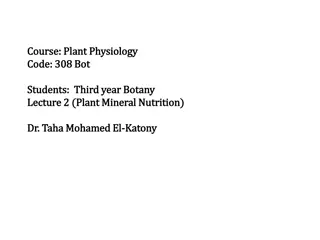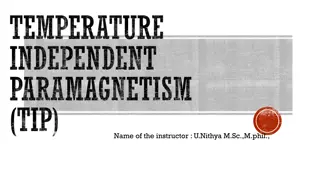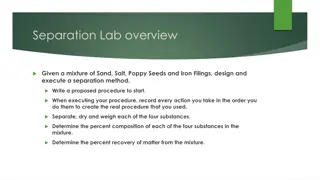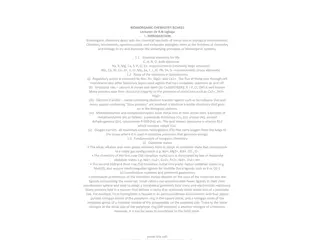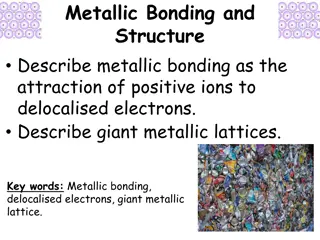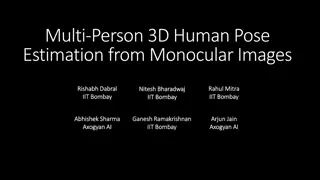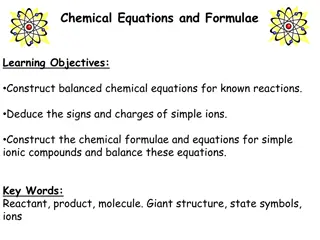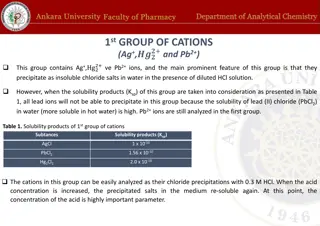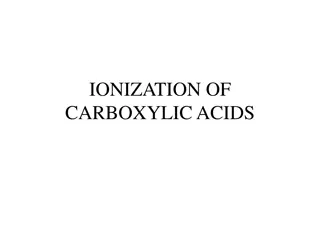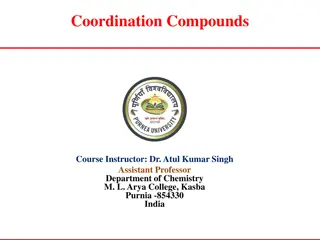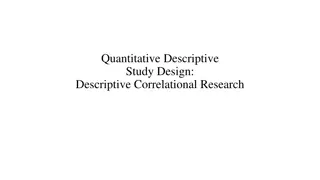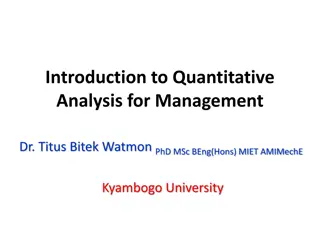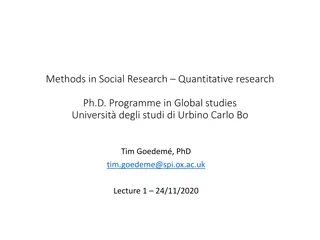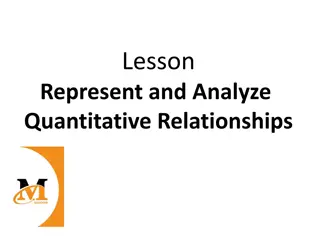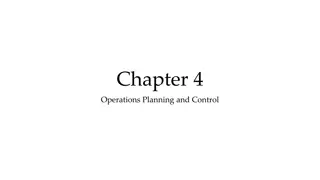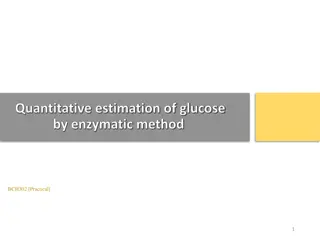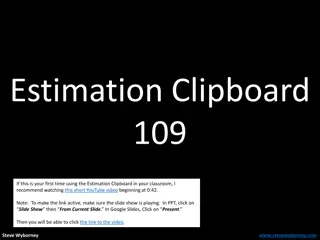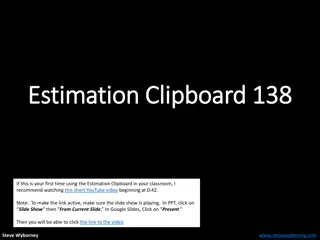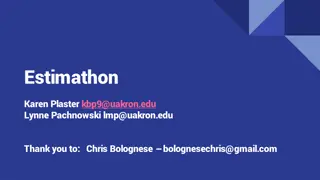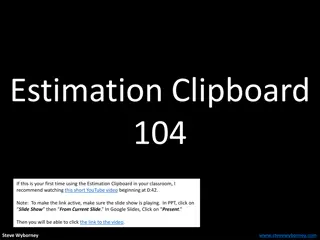Quantitative Estimation of Metal Ions in a Mixture
Dr. Saadia Rashid Tariq explains the quantitative estimation of copper(II), calcium(II), and chloride in a mixture. The process involves iodometric titration for copper(II), complexometric titration for calcium(II), and gravimetric estimation for chloride. Detailed procedures, reactions, requirements, and images are provided.
Download Presentation

Please find below an Image/Link to download the presentation.
The content on the website is provided AS IS for your information and personal use only. It may not be sold, licensed, or shared on other websites without obtaining consent from the author. Download presentation by click this link. If you encounter any issues during the download, it is possible that the publisher has removed the file from their server.
E N D
Presentation Transcript
METAL ION ESTIMATION: QUANTITATIVE ESTIMATION OF COPPER (II), CALCIUM (II) AND CHLORIDE IN A MIXTURE Dr. Saadia Rashid Tariq
QUANTITATIVE ESTIMATION OF COPPER (II), CALCIUM (II) AND CHLORIDE FROM A MIXTURE In this experiment the chloride ion is separated by precipitation with silver nitrate and estimated. Whereas copper(II) is estimated by iodometric titration and Calcium by complexometric titration Iodometric estimation of copper (II): Copper solution oxidizes potassium iodide and liberates iodine; liberated iodine is estimated by sodium thiosulphate. The reactions involved are: 2Cu2++4I- 2Cu+ +2I2 and 2I2+2S2O32- 2I- +S4O62- Take stock solution (25 ml) in a conical flask (250 ml) and add potassium iodide (1 g) to it. Iodine is liberated in the solution. Titrate the liberated iodine with standard sodium thiosulphate solution (0.1 M).
Complexometric estimation of calcium (II): During the complexometric titration of calcium (II), copper (II) ion can interfere if eriochrome black-T indicator is used. So copper (II) is reduced to copper (I) by using hydrazine hydrate and precipitated as copper thiocyanate by using ammonium thiocyanate. A calcium (II) ion is then titrated with ethylene diamine tertraceetic acid (EDTA). Ca2+ +H2Y2- CaY2- + 2H+, whereYH4 isEDTA No sharp end point can be obtained for calcium (II) with eriochrome black- T indicator, so small amount of Mg-YH2 should be added to get a sharp end point. Gravimetric estimation of chloride: Chloride can be estimated gravimetrically by precipitating it as silver chloride. An aqueous solution of chloride is generally acidified with dilute nitric acid to prevent precipitation of other silver salts.
REQUIREMENTS: 1. Stock solution of Cu2+, Ca2+ and Cl- ions. 2. Sodium thiosulphate 3. Starch solution 4. Potassium iodide 5. Erichrome Black-T 6. Nitric acid 7. Ammonium thiocyanate 8. Ethylene diamine tetra acetic acid 9. Hydrazine hydrate 10. Ammonia buffer 11. Silver nitrate AgCl AgNO3 + Cl-
PROCEDURE: Estimation of calcium (II): Take stock solution (25 ml) in a conical flask (250 ml). Add hydrazine hydrate (1 drop), a colourless solution will be observed. To this, add a solution of ammonium thiocyanate or potassium thiocyanate (10%, 5 ml) and filter the white precipitate. Take the filtrate in a conical flask and add ammonia- ammonium chloride buffer solution (2 ml, pH=10) and add Mg-EDTA (1 ml) to the filtrate. Titrate the solution with standard EDTA (0.01 M solution) using eriochrome black-T indicator. Calculate the amount of calcium in wt / lit and also express it as ppm. Estimation of chloride: Take stock solution (25 ml) in a conical flask. Acidify the solution with dilute nitric acid (1M, 10 ml), and then add silver nitrate solution (0.2 g / ml water). This will give a white precipitate of silver chloride. Filter the precipitate in a preweighed crucible. Place the crucible along with the precipitate in an oven (~ 500C) for 1hr after that cool the crucible to room temperature and weigh. Repeat the process of heating and weighing till constant weigh is obtained. Find out the weigh of silver chloride formed and find out the amount of silver.
SOLID PHASE SYNTHESIS OF TRANS- BIS GLYCINATO COPPER (II): Requirements: 1. Copper(II)acetate monohydrate 2. Glycine 3. Methanol / Ethanol 4. Diethyl ether 5. Sodium thiosulphate 6. Potassium iodide Procedure: Mix accurately weighed amount of copper (II) acetate monohydrate (2 g, 10 mmol) and glycine (2 g, 26.64 mmol) in an agate mortar at room temperature. Grind the mixture thoroughly in the mortar. Transfer the paste to a watch glass and leave it for 2 hrs. The colour of the mixture will change from green to pale blue. In 2 hrs, all the reactants will be exhausted. Wash the product with alcohol followed by ether and dry it in vacuum. Tasks: 1. Calculate percentage yield Estimate copper Find out the molar conductance in water Record the IR spectra of glycine and the complex and interpret.
Estimation of copper: Decompose an accurately weighed ( 0.10 - 0.15 g ) copper complex in sulphuric acid (1M). The resulting solution contains aqueous-copper sulphate, estimate copper iodometrically.



